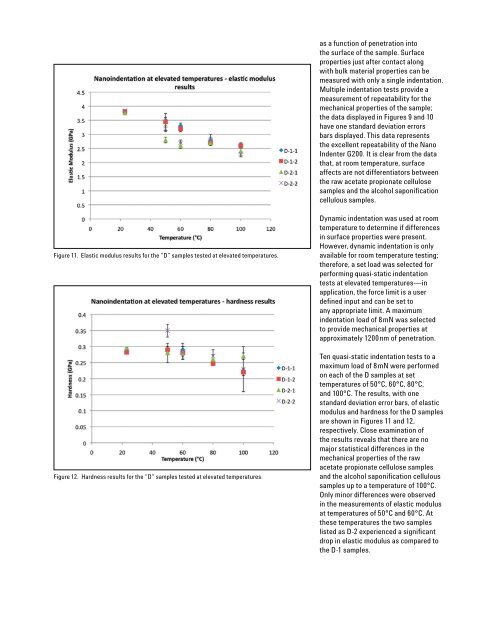Application Compendium - Agilent Technologies
Application Compendium - Agilent Technologies
Application Compendium - Agilent Technologies
Create successful ePaper yourself
Turn your PDF publications into a flip-book with our unique Google optimized e-Paper software.
Figure 11. Elastic modulus results for the “D” samples tested at elevated temperatures.<br />
Figure 12. Hardness results for the “D” samples tested at elevated temperatures.<br />
7<br />
as a function of penetration into<br />
the surface of the sample. Surface<br />
properties just after contact along<br />
with bulk material properties can be<br />
measured with only a single indentation.<br />
Multiple indentation tests provide a<br />
measurement of repeatability for the<br />
mechanical properties of the sample;<br />
the data displayed in Figures 9 and 10<br />
have one standard deviation errors<br />
bars displayed. This data represents<br />
the excellent repeatability of the Nano<br />
Indenter G200. It is clear from the data<br />
that, at room temperature, surface<br />
affects are not differentiators between<br />
the raw acetate propionate cellulose<br />
samples and the alcohol saponification<br />
cellulous samples.<br />
Dynamic indentation was used at room<br />
temperature to determine if differences<br />
in surface properties were present.<br />
However, dynamic indentation is only<br />
available for room temperature testing;<br />
therefore, a set load was selected for<br />
performing quasi-static indentation<br />
tests at elevated temperatures—in<br />
application, the force limit is a user<br />
defined input and can be set to<br />
any appropriate limit. A maximum<br />
indentation load of 8mN was selected<br />
to provide mechanical properties at<br />
approximately 1200nm of penetration.<br />
Ten quasi-static indentation tests to a<br />
maximum load of 8mN were performed<br />
on each of the D samples at set<br />
temperatures of 50°C, 60°C, 80°C,<br />
and 100°C. The results, with one<br />
standard deviation error bars, of elastic<br />
modulus and hardness for the D samples<br />
are shown in Figures 11 and 12,<br />
respectively. Close examination of<br />
the results reveals that there are no<br />
major statistical differences in the<br />
mechanical properties of the raw<br />
acetate propionate cellulose samples<br />
and the alcohol saponification cellulous<br />
samples up to a temperature of 100°C.<br />
Only minor differences were observed<br />
in the measurements of elastic modulus<br />
at temperatures of 50°C and 60°C. At<br />
these temperatures the two samples<br />
listed as D-2 experienced a significant<br />
drop in elastic modulus as compared to<br />
the D-1 samples.

















